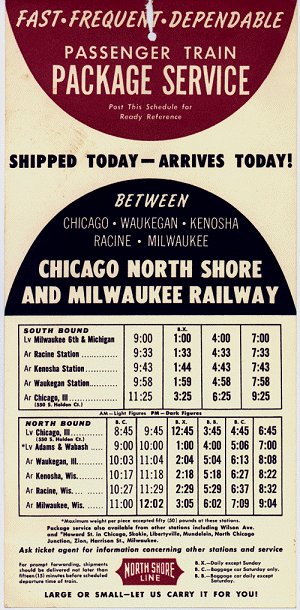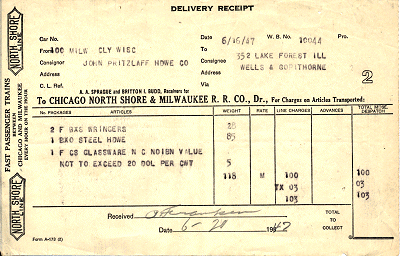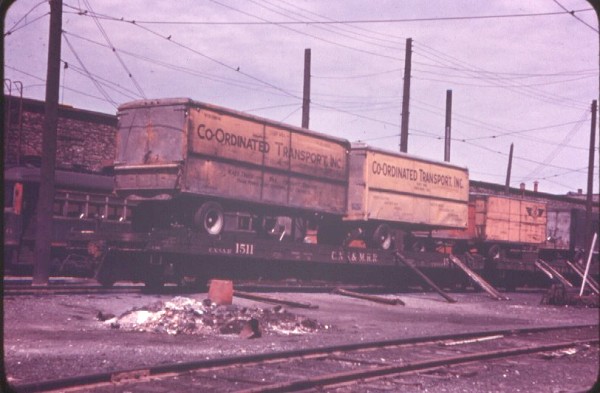 NSL Freight Timetable
NSL Freight Timetable
Welcome to the MD (merchandise despatch) page!! Spelled that way on purpose!
Please be sure to visit the pictures of MD/Freight Stations of the NSL (click on the blue link).
This is page designed to brag about the North Shore Line in another "relm"!
 NSL Freight Timetable
NSL Freight Timetable
As early as 1905, the freight and express revenues of ~ $250,000 made up some of 40% of the Chicago and Milwaukee Electric Railway.
The C&ME in 1902 operated an express service from Evanston to Waukegan and by 1912, four daily express trains carried and average of 30 milk cans from rural areas to Evanston and Milwaukee. These express trains were under contract to U.S. Express Company.
By 1910 the C&ME transported ~5000 freight carloads annually. These loads were mostly stone, gravel, and coal. Freight equipment consisted of two electric locomotives and more than 100 standard freight cars.
The C&ME connected their carload freight traffic with EJ&E and the Milwaukee Road at Roundout and connections were also made with the Wisconsin Central (SOO) at Rockefeller (Mundelein). The C&NW also connected at Great Lakes and Niles Center.
In 1917 a year after Insull acquired the NSL, the Railroad inaugurated a fast Merchandise Despatch service for express and L-T-C (less-than-carload) freight traffic. This became highly profitable.
L-T-C shipments on steam railroads took 2-8 days on shipments between Chicago and Milwaukee. The NSL charged one-third higher prices compared to steam railroads, but the NSL guaranteed overnight delivery, and their service was popular.
Before 1919 the MD service used old passenger cars with the seats removed for MD cars. After 1919, 20,000 tons a month was being moved; the NSL ordered the first of a series of specially designed MD cars.
The Cincinnati Car Company delivered 12 of the composite wood and steel cars early 1920. Each of these cars could carry 20 tons. They were 50' long and weighed 33 tons. Two 140 horsepower motors (similar to those on passenger cars) moved these cars with the option to convert them to four motor cars. The controls and air brakes were identical to those on NSL passenger cars.
The NSL also made waves to Michigan. Crosby Line steamships (operated between Milwaukee and Muskegon), the Grand Rapids, Grand Haven & Muskegon Railway, Michigan Railway, and Detroit United Railway offered freight service between southern Michigan and NSL points in 1919. Steam railroad service took as long as 2 weeks, while the Interurban-Steamship route offered third morning service.
NSL officials would meet with local farmers and after one such sales meeting, the NSL hauled over 100 cars of sugar beets and cabbage from a single station.
Due to the NSL innovations the revenues from freight and merchandise traffic increased faster than passenger traffic, and went from $60,000 in 1916 to $470,000 in 1920 and in 1923 total freight and express revenues exceeded 1 million for the first time in company history.
1922, fifteen new cars were delivered to the NSL from Cincinnati Car Company that allowed for ice refrideration and electric heating.
After completion of the Skokie Valley Route, the increase in freight traffic was incredible.
1926, the NSL was the second railroad to order insulated, mechanicaly operated refridgeration cars from the Cincinnati Car Company. These cars were powered by a 600 volt DC motor the got it's power directly from the trolley wires. However, these cars did not have traction motors, yet each did have control equipment adn cabs at each end.
May 1926 the North Shore Line began it's "Ferry-Truck" service. Ferry-cars were loaded with the shippers semi-trailers at either the Montrose Freight terminal in Chicago, Harrison Street in Milwaukee, Kenosha or Racine.
These Ferry Truck cars were then coupled as a train and hauled to it's destination terminal by Merchandise Despatch cars acting as locomotives.
Cars 1500-1503 were built in 1926 and had a capacity of 2 semi-trailers. Cars 1504-1513 were built in 1927 and had a capacity of 3 semi-trailers.
These special flat cars, ordered from Standard Steel Car Company had locking devices which secured the semi-trailers. The semi-trailers were specially ordered and those owned prior were modified. These cars are similar to the cars used today for piggyback rail transport.
This service by the North Shore Line also included pick-up and drop off of the semi-trailers at the customers desired places.
The North Shore Line was the FIRST in piggy back transport!
 Waybill courtesy of Tony Pignaloni
Collection
Waybill courtesy of Tony Pignaloni
Collection
In the late 1920's there were no large overhead cranes to use to load and unload the trailers. The only way to load the trailers were to back the trailer down the entire length of the train using tractors, drop it off and repeat the process for every trailer to be loaded. Steel gangplanks covered the gaps between the cars.
In 1932 the NSL added service by shipping the complete truck, which was then driven to the customers place of business.
The north bound freights left Montrose Avenue ground level terminal late at night. They traveled up the Wilson Avenue ramp 2 blocks north and then proceeded north over "L" track 1. At Howard Street the trains headed west on the Skokie branch northward.
These trains were powered by two 4- motor Merchandise Despatch cars, with another MD car in the caboose position. This rear MD car would be used to push heavy loads up the Wilson grade. At 2 am this "L" track #1 structure from Howard to WIlson was used for southbound traffic only. The Milwaukee to Chicago piggy-back would arrive just before dawn.
Gauntlet tracks were installed on the Skokie branch to provide clearance of the loads due to the height required for the trailers piggy-backed. These gauntlets included a pair of third rails and four running rails. As each train approached the station, it would stop and the front-end brakeman would get off and unlock and turn the switch. He then got back on and when the last car cleared the switch the train stopped again to reverse the process with the rear-end brakeman.
In 1943, 18,000 trailers were hauled.
In 1947 the end of the piggy-back "Ferry-Truck" service came to an end. It became unprofitable due to inter-city highways and faster motor cars.

CLICK HERE TO GO TO FREIGHT STATIONS PICTURES.
 Click on the ticket to return to
History Page
Click on the ticket to return to
History Page
 Click on the sign to return to North
Shore ticket office
Click on the sign to return to North
Shore ticket office